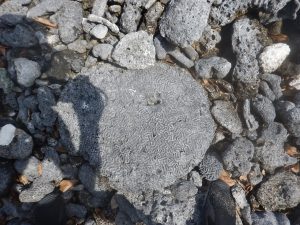Day 10: May 24th 2018, Glover’s Atoll
We woke for the first time by Glover’s Atoll and ate breakfast at 7. I think we all agree tat Marie Sharp knows how to do condiments. Ya’ll should look up the brand. Then we started to look at the technique we’d we using for our 1st project at Glovers. Essentially we would lay 100 ft of transect tape out, and place our quadrat (basically a squares with a bunch of little squares in it to measures things) out the side of the transect tape every 20 ft. We would then measures something using the squares by asking where each square had the thing we were measuring or didn’t. We did this first with the leaves in the ground of the trails, asking ‘does each square have a leaf or doesn’t it?’. We then moved to the seagrass beds around the island as we looked for worm sand mounds, asking ‘does each square have a worm sand mound or a portion of one in it?’. We found that about 3.8% of the seagrass floor around Glover’s contained some amount of sand worm mound.
We breaked before lunch, and I went around collecting hermit crabs in my hat, naming them George, and testing them for the hermit crab derby we want to have. I also chased several iguanas and even managed to touch the tail of one, not a small feat I am told. I also almost caught a small blue crab but it got away. Let’s just say I feel like I feel like a kid in a candy store here with all the crabs and lizards. After lunch, we walked to a coral graveyard on the island full of largely intact coral skeletons and fragments. The holes present where the polyps (the living organism inside the coral skeleton) used to live. Used my limited hard coral identification knowledge to id several types of hard coral using their skeletons including the Great Star Coral (Montrastraea cavernous) which had extremely large, deep, spaced holes where its large bulbous polyps used to live. I also found the skeleton of what I believe to be a Pillar Coral (Dendrogyra cylindrus) with ridged holes where the polyp used to be. We also saw several benched of coral dotted with polyps holes. The skinny pointed branches were Elkhorn Coral (Acropora palmata) and the the broader plates were Staghorn Coral (Acropora cevicornis). I also saw several otters types including the Rough Cactus Coral (Mycetophylla ferox), the Symmetrical Brain Coral (Pseudodiploria strigosa), the Smooth Star Coral (Solanestra bournoni), and the Maze Coral (Meandrina meandrites),
After getting back from the graveyard, we geared up, got on a boat, and got in the water around two reef patches, on in a protect marine area and one not. At each we used the transect and quadrat technique to look at the the live hard coral coverage on the reef benthos. After we finished collecting data, we snorkeled around for a bit. We observed a small Spiny Sea Urchin and a
Spotted Moray Eel in addition to several colorful fish. I observed several varieties of hard coral including several different types of brain coral, often incrusting over rocks and in some yellow color. I also observed a small yellowish Maze Coral alone on the reef benthos. There was even a live Staghorn Coral about 2 feet tall surrounded by what looked like fire corals. Sadly, the ground was also littered with dead one and broken branches.
After we got back, we ate dinner, got out things inside (due to rain), and then had lectures for Green Algae, Soft Corals, and the Future of Coral Reefs. We also discovered that hermit crabs like coconut. After that, we were off to bed (after I bothered some of the Blue Crabs).


Kristen, I can’t wait to see your stony coral pics when you get back. Dendrogyra cylindrica is awesome. See if you can find some live Eusmilia fastigiata… they have really huge polyps (even bigger than Montastrea cavernosa!)